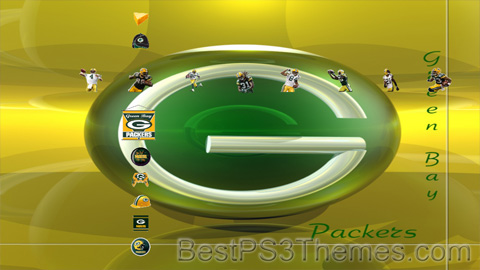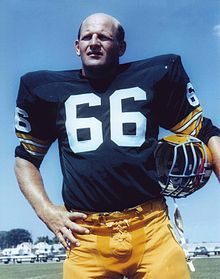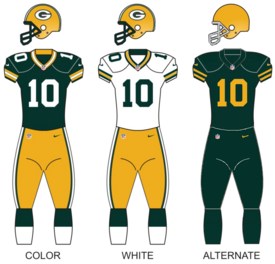Green Bay Packers theme by 1_BAD_SOLDIER
Download: GreenBayPackers_2.p3t

(2 backgrounds)
| Green Bay Packers | |||||
|---|---|---|---|---|---|
| Established August 11, 1919[1] First season: 1919 Play in and headquartered at Lambeau Field Green Bay, Wisconsin | |||||
| |||||
| League/conference affiliations | |||||
Independent (1919–1920)
| |||||
Current uniform | |||||
| Team colors | Dark green, gold, white[2][3] | ||||
| Fight song | "Go! You Packers Go!" | ||||
| Website | packers.com | ||||
| Personnel | |||||
| Owner(s) | Green Bay Packers, Inc. (537,460 stockholders – governed by a Board of Directors)[4][5] | ||||
| Chairman | Mark Murphy | ||||
| CEO | Mark Murphy | ||||
| President | Mark Murphy | ||||
| General manager | Brian Gutekunst | ||||
| Head coach | Matt LaFleur | ||||
| Team history | |||||
| |||||
| Team nicknames | |||||
| Championships | |||||
| League championships (13†[9][10]) | |||||
| Conference championships (9) | |||||
Division championships (26)
| |||||
| Playoff appearances (36) | |||||
| Home fields | |||||
| Team owner(s) | |||||
| |||||
The Green Bay Packers are a professional American football team based in Green Bay, Wisconsin. Competing in the National Football League (NFL) as part of the National Football Conference (NFC) North division, the Packers are the third-oldest franchise in the NFL, established in 1919.[11][12] They are the only non-profit, community-owned major league professional sports team based in the United States.[a][13] Since 1957, home games have been played at Lambeau Field. They hold the record for the most wins in NFL history.[14][15]
The Packers are the last of the "small-town teams" that were common in the NFL during the league's early days of the 1920s and 1930s. Founded in 1919 by Earl "Curly" Lambeau and George Whitney Calhoun, the franchise traces its lineage to other semi-professional teams in Green Bay dating back to 1896. Between 1919 and 1920, the Packers competed against other semi-pro clubs from around Wisconsin and the Midwest, before joining the American Professional Football Association (APFA), the forerunner of today's NFL, in 1921. In 1933, the Packers began playing part of their home slate in Milwaukee until changes at Lambeau Field in 1995 made it more lucrative to stay in Green Bay full-time; Milwaukee is still considered a home media market for the team.[16][17][18] Although Green Bay is the smallest major league professional sports market in North America,[a][19] Forbes ranked the Packers as the world's 27th-most-valuable sports franchise in 2019, with a value of $2.63 billion.[20]
The Packers have won 13 league championships, the most in NFL history, with nine pre-Super Bowl NFL titles and four Super Bowl victories. The Packers, under coach Vince Lombardi, won the first two Super Bowls in 1966 and 1967; they were the only NFL team to defeat the American Football League (AFL) before the AFL–NFL merger. After Lombardi retired, the Super Bowl trophy was named for him, but the team struggled through the 1970s and 1980s. Since 1993, the team has enjoyed much regular-season success, making the playoffs 23 times and winning two Super Bowls in 1996 under head coach Mike Holmgren and 2010 under head coach Mike McCarthy.[21] The Packers have the most wins (826) and the second-highest win–loss record (.571) in NFL history, including both regular season and playoff games.[22][23] The Packers are longstanding adversaries of the Chicago Bears, Minnesota Vikings, and Detroit Lions, who today form the NFL's NFC North division (formerly known as the NFC Central Division). They have played more than 100 games against each of those teams, and have a winning overall record against all of them, a distinction only shared with the Kansas City Chiefs, Dallas Cowboys, and Miami Dolphins. The Bears–Packers rivalry is one of the oldest rivalries in U.S. professional sports history, dating to 1921.
Franchise history[edit]

Curly Lambeau years (1919–1949)[edit]
The Green Bay Packers were founded on August 11, 1919,[1] by former high-school football rivals Earl "Curly" Lambeau and George Whitney Calhoun.[24] Lambeau solicited funds for uniforms from his employer, the Indian Packing Company, a meat packing company.[25] He was given $500 ($8,800 today) for uniforms and equipment, on the condition that the team be named after its sponsor.[26] The Green Bay Packers have played in their original city longer than any other team in the NFL.
On August 27, 1921, the Packers were granted a franchise in the American Professional Football Association, a new national pro football league that had been formed the previous year. The APFA changed its name to the National Football League a year later. Financial troubles plagued the team, and the franchise was forfeited within the year before Lambeau found new financial backers and regained the franchise the next year. These backers, known as "The Hungry Five", formed the Green Bay Football Corporation.[27]
NFL champions (1929, 1930, 1931)[edit]
After a near-miss in 1927, Lambeau's squad claimed the Packers' first NFL title in 1929 with an undefeated 12–0–1 campaign, behind a stifling defense which registered eight shutouts.[28] Green Bay would repeat as league champions in 1930 and 1931, bettering teams from New York, Chicago and throughout the league, with all-time greats and future Hall of Famers Mike Michalske, Johnny (Blood) McNally, Cal Hubbard and Green Bay native Arnie Herber.[29][30] Among the many impressive accomplishments of these years was the Packers' streak of 29 consecutive home games without defeat, an NFL record which still stands.[31]
NFL champions (1936, 1939, 1944)[edit]

The arrival of the end Don Hutson from Alabama in 1935 gave Lambeau and the Packers the most feared and dynamic offensive weapon in the game. Credited with inventing pass patterns, Hutson would lead the league in receptions in eight seasons and spur the Packers to NFL championships in 1936, 1939 and 1944. An Iron Man, Hutson played both ways, leading the league in interceptions as a safety in 1940. Hutson claimed 18 NFL records when he retired in 1945, many of which still stand.[32] In 1951, his number 14 was the first to be retired by the Packers, and he was inducted as a charter member of the Pro Football Hall of Fame in 1963.
After Hutson's retirement, Lambeau could not stop the Packers' slide. He purchased a large lodge near Green Bay for team members and families to live in. Rockwood Lodge was the home of the 1946–49 Packers. The 1947 and 1948 seasons produced a record of 12–10–1, and 1949 was even worse at 3–9. The lodge burned down on January 24, 1950, and insurance money paid for many of the Packers' debts.[33]

Curly Lambeau departed after the 1949 season. Gene Ronzani and Lisle Blackbourn could not coach the Packers back to their former magic, even as a new stadium was unveiled in 1957. The losing would descend to the disastrous 1958 campaign under coach Ray "Scooter" McLean, whose lone 1–10–1 year at the helm is the worst in Packers history.[34]
Vince Lombardi years (1959–1967)[edit]
Former New York Giants assistant Vince Lombardi was hired as Packers head coach and general manager on February 2, 1959. Few suspected the hiring represented the beginning of a remarkable, immediate turnaround. Under Lombardi, the Packers would become the team of the 1960s, winning five championships over seven years, including victories in the first two Super Bowls. During the Lombardi era, the stars of the Packers' offense included Bart Starr, Jim Taylor, Carroll Dale, Paul Hornung (as halfback and placekicker), Forrest Gregg, and Jerry Kramer. The defense included Willie Davis, Henry Jordan, Willie Wood, Ray Nitschke, Dave Robinson, and Herb Adderley.

The Packers' first regular-season game under Lombardi was on September 27, 1959, a 9–6 victory over the Chicago Bears in Green Bay. After winning their first three, the Packers lost the next five before finishing strong by sweeping their final four. The 7–5 record represented the Packers' first winning season since 1947, enough to earn rookie head coach Lombardi the NFL Coach of the Year.
The next year, the Packers, led by Paul Hornung's 176 points, won the NFL West title and played in the NFL Championship against the Philadelphia Eagles at Philadelphia. In a see-saw game, the Packers trailed by only four points when All-Pro Eagle linebacker Chuck Bednarik tackled Jim Taylor just nine yards short of the goal line as time expired.
NFL champions (1961, 1962, 1965)[edit]

The Packers returned to the NFL Championship game the following season and faced the New York Giants in the first league title game to be played in Green Bay. The Packers scored 24-second-quarter points, including a championship-record 19 by Paul Hornung, on special "loan" from the Army (one touchdown, four extra points, and three field goals), powering the Packers to a 37–0 rout of the Giants, their first NFL Championship since 1944.[35] It was in 1961 that Green Bay became known as "Titletown".
The Packers stormed back in the 1962 season, jumping out to a 10–0 start on their way to a 13–1 season. This consistent level of success would lead to Lombardi's Packers becoming one of the most prominent teams of their era, and to be featured as the face of the NFL on the cover of Time on December 21, 1962, as part of the magazine's cover story on "The Sport of the '60s".[36] Shortly after Time's article, the Packers faced the Giants in a much more brutal championship game than the previous year, but the Packers prevailed on the kicking of Jerry Kramer and the determined running of Jim Taylor. The Packers defeated the Giants in New York, 16–7.
The Packers returned to the championship game in 1965 following a two-year absence when they defeated the Colts in a playoff for the Western Conference title. That game would be remembered for Don Chandler's controversial tying field goal in which the ball allegedly went wide right, but the officials signaled "good". The 13–10 overtime win earned the Packers a trip to the NFL Championship game, where Hornung and Taylor ran through the defending champion Cleveland Browns, helping the Packers win, 23–12, to earn their third NFL Championship under Lombardi and ninth overall. Goalpost uprights would be made taller the next year.
Super Bowl I champions (1966)[edit]

The 1966 season saw the Packers led to the first-ever Super Bowl by MVP quarterback Bart Starr. The team went 12–2, and as time wound down in the NFL Championship against the Dallas Cowboys, the Packers clung to a 34–27 lead. Dallas had the ball on the Packers' two-yard line, threatening to tie the ballgame. But on fourth down the Packers' Tom Brown intercepted Don Meredith's pass in the end zone to seal the win. The team crowned its season by rolling over the AFL champion Kansas City Chiefs 35–10 in Super Bowl I.
Super Bowl II champions (1967)[edit]
The 1967 season was the last for Lombardi as the Packers' head coach.[37] The NFL Championship game, a rematch of the 1966 contest against Dallas, became indelibly known as the "Ice Bowl" as a result of the brutally cold conditions at Lambeau Field.[38] Still the coldest NFL game ever played, it remains one of the most famous football games at any level in the history of the sport.[39] With 16 seconds left, Bart Starr's touchdown on a quarterback sneak brought the Packers a 21–17 victory and their still unequaled third straight NFL Championship. They then won Super Bowl II with a 33–14 victory over the Oakland Raiders. Lombardi stepped down as head coach after the game, and Phil Bengtson was named his suc



